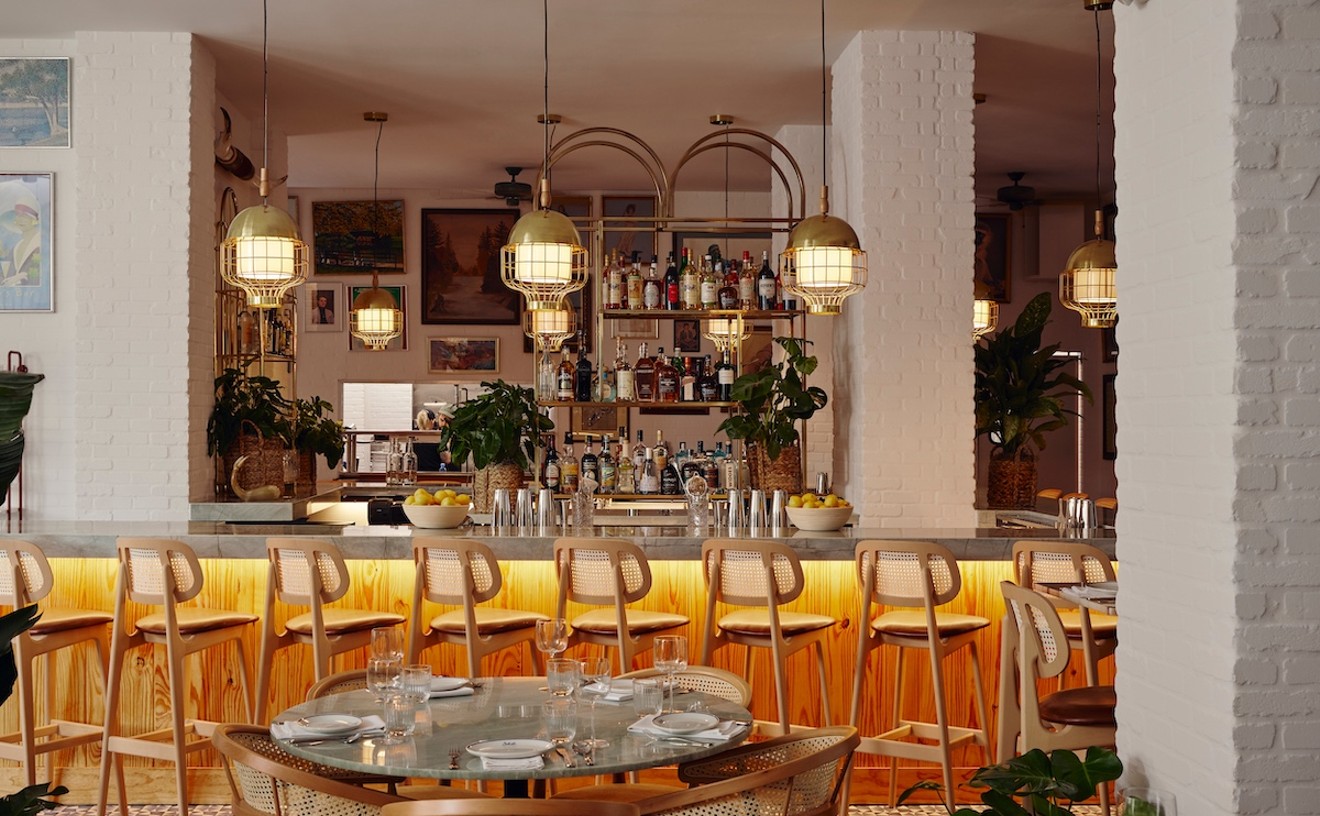But have you ever wondered what becomes of your phone number the next day? I have. As an unlisted food critic who makes her reservations under a variety of aliases, I hesitate to leave my real phone number with a host; I know smart proprietors keep their reservation logs and even transfer them to computer databases. Standard practice gives me no choice if I want to ensure my table, however, so I do it. Reluctantly, because I always fear being tracked down by some enterprising restaurateur with a yen for blowing my cover.
Which is why I didn't answer my phone the day after I dined at the newly retooled Astor Place, the restaurant in the Hotel Astor in South Beach. The call came in about noon; my caller ID displayed the Hotel Astor's phone number; and I panicked. This was it, I thought. After seven years of virtual anonymity, somebody finally recognized me and wanted me to know I'd been uncovered.
But as it happens every so often (though not frequently), I was wrong. Turns out I realized the hostess at Astor Place was simply following the first rule of public relations. She was calling all her reservations from the night before -- not just me -- to see if we had any helpful comments about the food and service to pass along to the manager and chef. She'd appreciate a call back, she added, if I had the time or inclination, and wanted them to know anything that could help them in the future.
Wait. Whoa. A restaurant doing followup? Like they really cared? Like they were actually concerned about me after they took me for a few hundred bucks, not including an outrageous $12 valet parking fee? And in South Beach, capital of quick capital, no less?
Perhaps I shouldn't be so surprised that Astor Place is trying to rebuild its clientele, many of whom abandoned the eatery when original chef Johnny Vinczencz departed for the new Billboard restaurants set to open on the Beach in the fall. After all, owner Karim Masri, who is also a partner in Vinczencz's informal sandwich joint, Johnny V's, had a successful run of several years with this Art Deco redo, a handsome and elegant eatery sunk below street level and positioned next to the hotel pool. In addition to Vinczencz's interpretative fusion cuisine, folks were attracted to the décor -- terrazzo floor, cherry woods, potted palms, and glassed-in ceiling -- as well as the elite but transient ambiance of a celebrity-frequented restaurant.
As they are wont to do, though, the celebrities have gone home to wherever home is, and Masri needs to woo not them, but the locals back to his digs. Left sans chef, he enlisted the help of Miami's own star, Norman Van Aken of Norman's in Coral Gables. Not only did Van Aken redesign the menu and teach his recipes to chef de cuisine Paul Griffin, he installed chef Russell Parker to act as liaison between Norman's and Astor Place. Parker's orders: to ensure Van Aken-prescribed perfection. Think of it as restaurateuring meeting the armed services. Welcome to the new culinary regime.
Diplomacy (making every diner feel important) is one of Van Aken's fortes. He's an excellent manager, as can be seen at his signature restaurant. Norman's just might be the only eatery in town that is booked solid on Monday nights. Try to get a reservation on a weekend, and if you're lucky, you still have to give the host your credit card number. If you don't show, Norman's threatens to charge you 25 bucks per person. If you do show, you're liable to have the one of the best meals of your life. And pay a whole lot , though that's an understatement, for the privilege. Van Aken also likes to use his time wisely in training his waitstaff with the precision of a marksman. It may be unheard of in South Beach, but now at Astor Place, when the water glass is empty, the busboy refills it. Bam. When the wine glass is empty, the server refills it with a vintage chosen from an extensive but not cheap international list. Bam. When the plate of seared foie gras, artfully posed over a sweet corn arepa with sugar-cane moonshine chutney, is empty, well, unfortunately the server just takes it away. Boo.
Because, of course, as it is at Norman's, the fare must be the focus at Astor Place. If you had to compare the two restaurants, I'd sum it up this way: Norman's is a little more elaborate and over-the-top, with smaller portions but a bigger buzz. Astor Place actually benefits from Van Aken's self-imposed restraint and offers more food for your money, which is quick to disappear at either establishment. So why eat at Norman's, where you can't get a table, instead of Astor Place, which hasn't yet been overrun by overeager foodies?
Simple: Van Aken can invest as much of himself as he possibly can, but his role is consultant. Period. The effect comes down to execution. When the ten-dollar "Double D" appetizer (a torta stuffed with braised duck and drizzled with passion fruit vinaigrette) tastes like it has been pre-prepared and stuck in the refrigerator, and the wild mushroom-ricotta crêpe starter, similar to the torta, is barely warmed, you begin to wonder just how long it will take you to get from Washington Avenue to Almeria Avenue.
Persevere. After providing limited gratification with the aforementioned starters (the only two missteps we encountered), the kitchen came through with the shrimp St. Barts appetizer. Hinting at curry spices, the grilled jumbos, big and sweet enough to qualify as prawns, were arranged around a hearts-of-palm slaw that had a melting yet firm texture, and was napped with a Caribbean vichyssoise créma as sweet as boniatos. The paper-and-fire spring rolls inspired fights among my guests over just who would consume the last of the rice paper-wrapped charred beef, exquisitely rare and tender. The succulence of the meat was enhanced here by a hearty green papaya slaw, finished with a dab of sesame-honey-mustard dressing.
Entrées were Norman's simplified, but the taste was complicated, and that's the way I like it. Particularly the Key West snapper, which benefited from a complex sauce comprising peanuts, scallions, garlic, and piquillo peppers. Pan-seared to a delicate crispness and wrapped around a body of boniato mash, the thin skin of fish was unquestionably the fillet of the evening. Unless you care to argue for a meatier entrée, which arrived with a smear of "broken olive butter" on top and braised short ribs as a side dish. Titled "beef two ways," the succulent Black Angus beef was just a touch firmer than the butter melting on top. The short ribs, robust in a Rioja reduction, were complemented further by the rootiness of a West Indian pumpkin (squash) mash.
With Van Aken you can't always rely on reading comprehension to provide you with a sense of what the dish will actually be like. Take the chimichurri tuna. Surrounding a yuca hash cake, the sliced tuna was actually almost sushi, lightly seared but truly raw. A key lime mustard oil, slightly pungent but not overwhelming, lent some heat to the medallions of cool, rare fish. Pork tenderloin proved just as tender as the tuna, but a mishmash of Cuban-inspired ingredients gave it less definition. Still, it was difficult to argue with the rich outcome: mouthfuls of grilled pork, black beans, plantain tamal, and sour cream.
Desserts also proved innovative, with a fragrant peach tiramisu breaking my resolve never to eat that overdone dessert again. A bonanza of triple-layer, key lime-scented treats (mousse, cake, and candied shell) is as fulfilling as the check -- when it arrives -- is startling.
So in the end, it doesn't really matter which restaurant you choose, Norman's or Astor Place. Both promise excellence. Both, with a few minor differences, benefit from Van Aken's influence. Both follow through, and charge you for it. But only Astor Place, not yet cashing in on cachet, will call you the day after.










